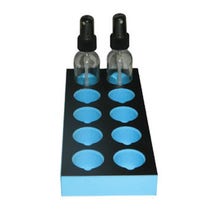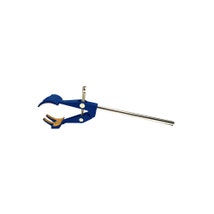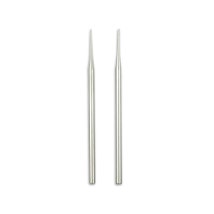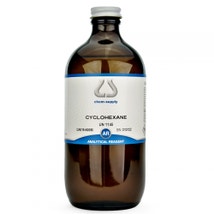Joules Calorimeter, Fully Assembled, 6 ohms, Each
Joule’s Calorimeter is designed for conducting the electrical method of determining the specific heat capacity of a liquid. It is a valuable tool for professional laboratories, science classrooms, and home-based experiments.
Calorimeter Construction
The calorimeter consists of a nickel-plated copper vessel, measuring 76mm in height and 51mm in diameter. This inner vessel is lagged for insulation and enclosed within an outer container measuring 102mm in height and 70mm in diameter, reducing heat loss during experiments.
Lid & Stirring Mechanism
A close-fitting ebonite lid is included, featuring a built-in wire stirrer. This ensures uniform heat distribution throughout the liquid sample, improving measurement accuracy.
Electrical Components & Resistance
The calorimeter is equipped with a pair of 4mm socket terminals, which connect to a constantan wire heating coil. The coil has a resistance of approximately 6 ohms and operates effectively with a current of 0.5A, with a maximum limit of 1A. The power supply is not included.
How to Avoid Corrosion
- Thoroughly dry the vessel after cleaning to prevent moisture-induced copper corrosion.
- Store the vessel in a cool, dry area with low humidity.
- For extra protection, wrap the vessel in a sealed plastic bag with silica gel packets to absorb residual moisture
DISCLAIMER! Breaches in the nickel plating may still pose a challenge in fully preventing corrosion.
Product Features
- Precision Measurement Tool: Designed for determining the specific heat capacity of liquids using the electrical method.
- Nickel-Plated Copper Vessel: Provides excellent thermal conductivity for accurate heat transfer.
- Lagged & Insulated Design: Reduces heat loss, ensuring precise experimental results.
- Close-Fitting Ebonite Lid: Helps maintain insulation and minimises external interference.
- Integrated Wire Stirrer: Ensures even heat distribution for reliable temperature readings.
- 4mm Socket Terminals: Allows secure electrical connections to a power source.
- Constantan Wire Heating Coil: Offers a 6-ohm resistance, suitable for 0.5A to 1A current applications.
- Versatile Usage: Ideal for laboratory, educational, and home science experiments.
Specification
| Label | Value |
|---|---|
| Type | Joules Calorimeter |
| Application | Electrical method for determining specific heat capacity of liquids. |
| Material (Inner Vessel) | Nickel-Plated Copper |
| Material (Lid) | Ebonite |
| Material (Heating Coil) | Constantan Wire |
| Electrical Terminals | 4mm Socket Terminals |
| Stirring Mechanism | Wire Stirrer |
| Coil Resistance | 6 ohms |
| Recommended Current | 0.5A (maximum 1A) |
| Inner Vessel Dimensions | 76mm (Height) x 51mm (Diameter) |
| Outer Vessel Dimensions | 102mm (Height) x 70mm (Diameter) |
Product Questions
How long will my delivery take?
Our Promise: Every order we receive before 2pm AEST will be despatched on the same day! Learn more.
Metropolitan Area
Adelaide, Melbourne, Sydney & Canberra
1-2 Business Days
Brisbane
2-3 Business Days
Darwin & Perth
3-5 Business Days
Regional Area
SA, VIC, NSW & ACT
2-3 Business Days
QLD
3-4 Business Days
NT, WA & TAS
4-6 Business Days
Specification
| Label | Value |
|---|---|
| Type | Joules Calorimeter |
| Application | Electrical method for determining specific heat capacity of liquids. |
| Material (Inner Vessel) | Nickel-Plated Copper |
| Material (Lid) | Ebonite |
| Material (Heating Coil) | Constantan Wire |
| Electrical Terminals | 4mm Socket Terminals |
| Stirring Mechanism | Wire Stirrer |
| Coil Resistance | 6 ohms |
| Recommended Current | 0.5A (maximum 1A) |
| Inner Vessel Dimensions | 76mm (Height) x 51mm (Diameter) |
| Outer Vessel Dimensions | 102mm (Height) x 70mm (Diameter) |
Product Questions
How long will my delivery take?
Our Promise: Every order we receive before 2pm AEST will be despatched on the same day! Learn more.
Metropolitan Area
Adelaide, Melbourne, Sydney & Canberra
1-2 Business Days
Brisbane
2-3 Business Days
Darwin & Perth
3-5 Business Days
Regional Area
SA, VIC, NSW & ACT
2-3 Business Days
QLD
3-4 Business Days
NT, WA & TAS
4-6 Business Days
| Qty | Saving | Price |
| 1-1 | - | |
| 2 -25 | 4 % | $26.10 |
| 26+ | 10 % | $24.60 |








